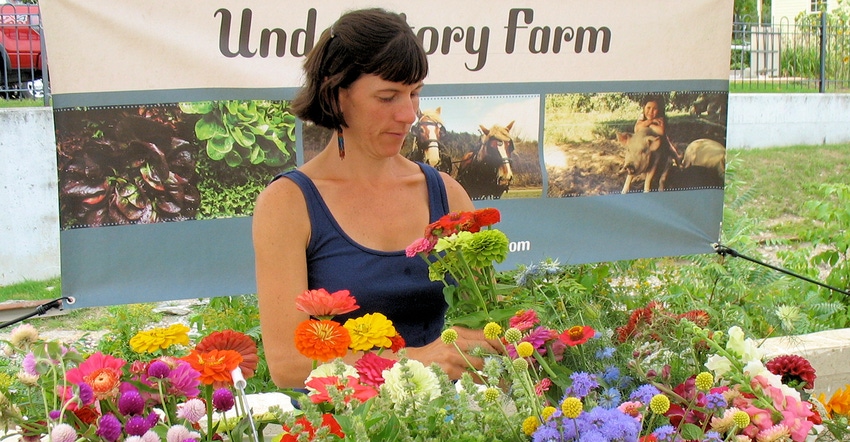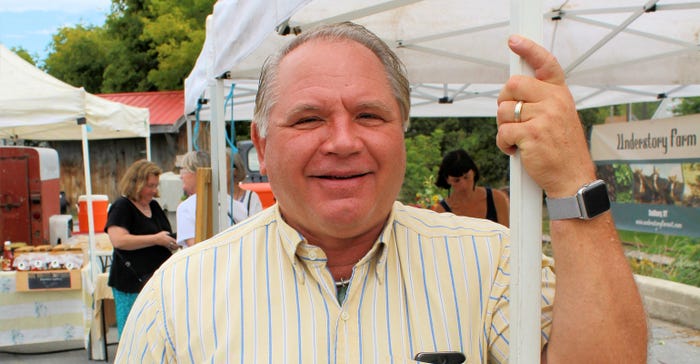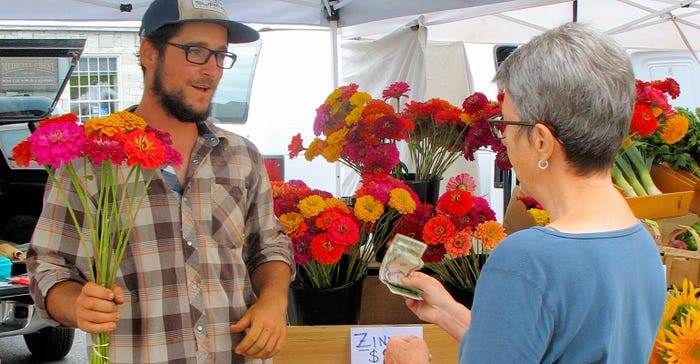February 8, 2017

Now’s the time to freshen your farmers market strategies. Never underestimate the social aspect, stresses Bruce Baker, merchandising consultant for the Middlebury (Vt.) Farmers Market and other markets. “Social is very important; it’s the binder,” he emphasizes. Successful marketers are very much a part of it.
“For every trend, there’s a countertrend. Today, so many people just sit in front of a computer and get fat. But at farmers markets, people walk around, taste something and run into someone they haven’t seen in 20 years.”
While the growth of farmers markets has slowed nationwide in recent years, a shakeout was inevitable. But the Middlebury Farmers Market is one of those still thriving — going strong since 1974. Its 40-some vendors generated about $350,000 in sales during 2015.
Baker, a jeweler, sees mistakes vendors make with craft show displays. In fact, that’s what inspired him to give workshops as a consultant.

MERCHANDISING MASTER: Bruce Baker has turned his merchandising success into a consulting role.

Tantalizing and drawing customers into your display is the key to profitable sales, he says. Vendors often take their cue from other vendors. Sometimes that’s good, sometimes not.
“Mistakes are often copied. One person sees it at another booth, then it spreads and propagates. It’s ‘monkey see, monkey do,’ until some new farmer has an idea and that one spreads.”
Winning display strategies
Baker has these suggestions for vendors who want a winning display and sales techniques:
• Connect with your customers. “Farmers assume that the customer knows. But they have no idea how little the customer knows,” he contends. So when someone asks how your produce is grown, explain — at least the good parts.
“People think farmers live the idyllic life. They don’t want to hear complaints about weather or weeds or bugs,” adds Baker. “They ask questions such as ‘why is this so expensive?’ What they really mean to ask is ‘why is it worth it?’ So explain, but don’t be defensive. Say, ‘Because it’s delicious. Here, taste it.’”
Before a customer buys something, they always have an objection. A good vendor answers that objection. Baker tells a story about a farmer who got cranky about people shucking his sweet corn before they bought it. “Customers just wanted to see what it looked like. But he thought it was a criticism of how fresh it was. So he began shucking it for them — and charging 10 cents an ear more.”
• Pay attention to the background. “A display should set a mood and virtually disappear,” he advises. “If someone says, ‘I love your tablecloth,’ you’ve missed the point.”
He suggests a stretchy cloth rather than a drape, in a plain color. “Calico and over-the-top coverings are big mistakes, especially burlap, which is expensive and looks dirty and scratchy,” he says.
Paint any visible wood. Customers tend to view unpainted wood as dirty and splintery.
• Think about traffic flow. “You don’t want would-be customers to feel they could get trapped in your display,” notes Baker. Any opening into your booth should be a minimum of 6 feet wide.
Don’t clutter the interior space. Consider your customers’ mindset: If only one person in a couple can get inside the booth, they’ll worry about leaving the other outside and won’t linger.
• Appeal to their senses. Invite customers to touch your merchandise. “We always want to touch it before we buy it,” Baker points out. “The touch response is second only to visual.”
Speaking of visual, look from the viewer’s angle. Display as many wares as possible at eye level. “People don’t want to stoop to see things, especially older people.”

MULTILEVEL DISPLAY: Displaying an abundance of flowers at multiple levels is a merchandising technique learned by Nick Cantrick of Tiny Truck Farm of E. Middlebury, Vt.

Display goods using chevroning (placing shelves or racks at an angle) to create a cornucopia effect — fabulous and bountiful, It’s a subtle invitation to customers to touch and buy. That move alone increased sales of one of his clients by 20%.
Don’t crowd things too tightly together, because people won’t touch them. “You want it to say, ‘Help yourself; it’s here for you,’” he adds. “When you use all the senses, that’s when you sell.” Put out samples for tasting, even play some music.
• Employ clear signage. Customers are often afraid to ask the price of goods, so make prices clear and easy to read via signs. Signs should also relay other information: For example, how many flowers are in a bunch? How can you cook a particular food?

LARGE MENU: Large, clear signs and prices should be near the front of the booth, adds Witscher.

“Signs are the silent salespeople. They say, ‘See it, smell it, taste it and tell a story.’ It takes a good product, a good display and good sales technique — it takes all three,” says this marketer.
“Farmers marketers are busy people” he acknowledges. But with just a little vision and extra effort, they can easily increase their market sales.
Harlow writes from Westminster Station, Vt.
About the Author(s)
You May Also Like




